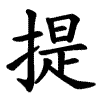提
- to lift;
- to raise;
- to carry in the hand;
- to bring up;
Etymology
Usage in Korean
提出 (제출) — to submit, to put forward
提案 (제안) — proposal, motion
提示 (제시) — to prompt, to point out
提起 (제기) — to raise (an issue), to arouse
提携 (제휴) — cooperation, alliance
提灯 (제등) — lantern (lit. “raised lamp”)
Words that derived from 提
Additional notes
Common in both literal senses (to lift, carry) and figurative senses (to raise an issue, to propose).
In Japanese, 提 is often read tei or sashi depending on compounds (e.g., 提案 teian, 提灯 chōchin).
In Korean history, 提 also appears in names and bureaucratic titles.
In Buddhist transliterations from Sanskrit, 提 is sometimes read as 리 (ri) in Korean.
Example: 菩提 (보리, Bodhi = enlightenment)
- Chinese pronunciation approximates bodi.
- In Korean, the “d” sound shifted to “r” by liquidization (ᄃ → ᄅ), producing “보리.”
This illustrates how Chinese transliteration characters were adapted phonetically into Korean, sometimes diverging significantly from their normal Sino-Korean reading.
- 手日一人 (QAMO)
- ⿰ 扌 是
